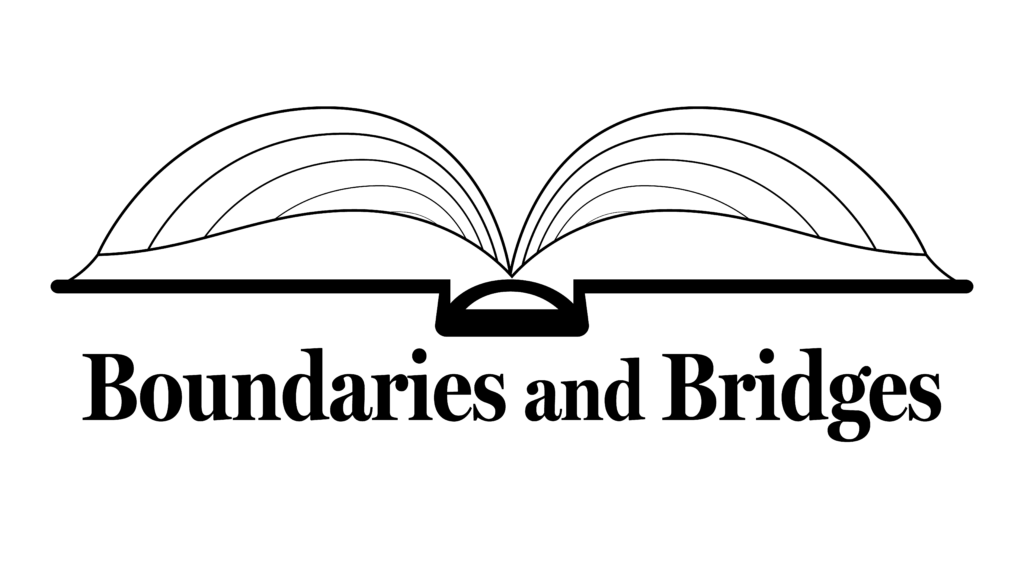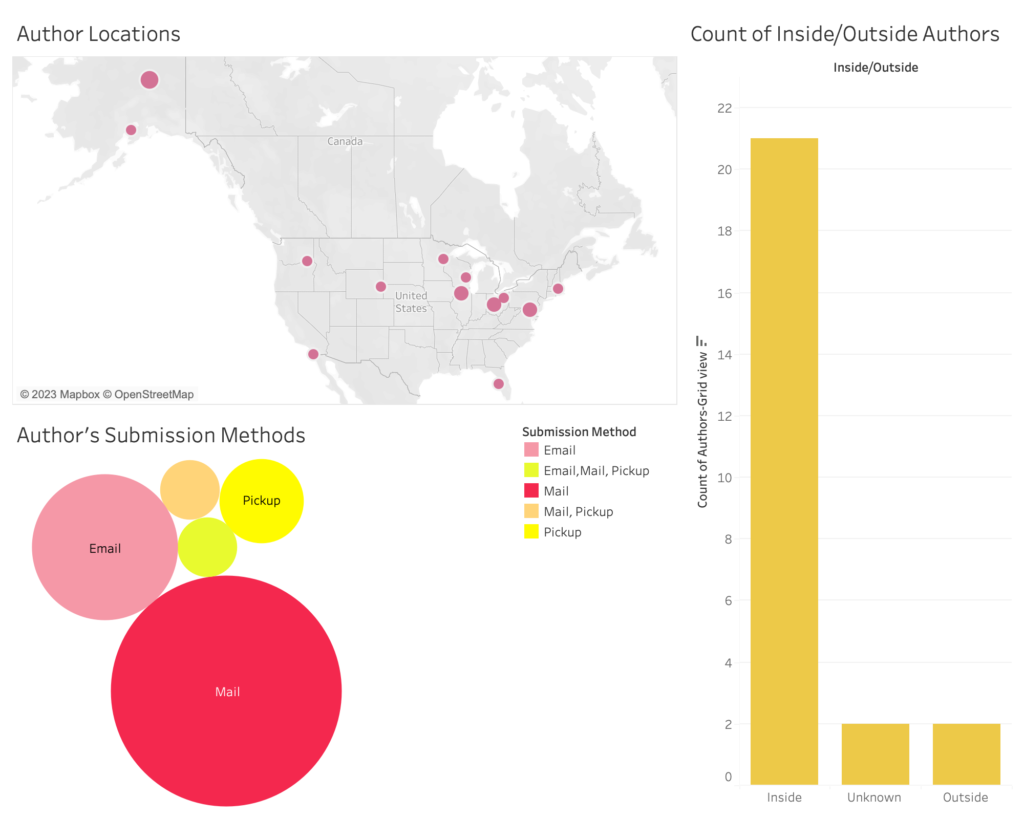
Volume 1
2023
Editors: Jaclyn Bergamino and Naomi Hutchquist
Editors’ Introduction
This project was borne from a group of teachers who had been facilitating creative writing courses in carceral settings across Alaska. We had taught at Fairbanks Correctional Center, Hiland Mountain Correctional Center, and Lemon Creek Correctional Center. We personally had been moved by the stories and words of the writers we worked with, and we wanted to share those words so that others could be moved as well. In these writers’ stories, we saw a system that failed people, a breakdown in the way we cared for each other, and we saw ourselves.
We realized that much of the work coming out of our writing sessions facilitated a great deal of catharsis. As writers shared their words, their stories brought tears, laughter, and sometimes anger into the room. But they also offered some form of relief. A heartache shared can alleviate suffering and begin healing, and we experienced this firsthand in our classes. We as teachers were also being transformed by these stories.
But there was something missing. Connection. Part of the power of the written word is the way that it can be shared across boundaries and over bridges. This collection seeks to take the catharsis of these works of art and create more opportunities for connection. We hope that these moments of connection help foster reintegration, understanding, and compassion.
Our hope is that these connections become bridges. Bridges that nurture literacy, and composition skills that will facilitate healthy reintegration and re-entry. Bridges that engender understanding between those who are incarcerated and those who might prefer to look the other way. Bridges that foster a sense of compassion that paves the way for a justice system rooted in restoration, resilience, and ultimately reconnection with society.
We also hope that this collection helps to create some boundaries. Boundaries on what kinds of punishment we as a society are willing to inflict, on what kinds of treatment we allow toward the most underserved in our society, and boundaries on the judgements passed between us
We owe a debt of gratitude to the writers at FCC, HMCC, and LCCC. This collection was inspired by the writing they did in our courses and the belief that these stories needed to be heard by more people. As the writers shared their work, it was clear that it was not only healing to share their own stories, but also to see themselves in the stories of their peers. It was as cathartic to connect with writing as it was to create it.
As we chose the pieces to include in the final collection, these moments of connection that happened in these courses stayed at the forefront of our minds. We often thought about the writers in our courses not only as the authors of the work, but also the audience. Which of these submissions that we received would create those moments of connection for them? Which would make them feel seen? Which would make them feel like they were not alone? Which would make them feel connected? These were the works we wanted in our StoryCube
While this collection started as a project in just a few women’s prisons in Alaska, the work in this collection represents writers from across the United States, from Fairbanks to Florida. We took a very broad view of our theme of boundaries and bridges, looking for poetry, visual art, and stories about connection and disconnection. The pieces in this collection were chosen for a variety of reasons. Some made us see things in a new way, some touched our hearts, and others moved us to demand changes in the justice system.
For this anthology, we selected two pieces by Alaskan Feral Goddess, one poetry and one creative nonfiction. “Inside-Outside,” the poem, explores the tension between what is felt inside and what is seen outside. It is a passionate, empowering manifesto on how the many facets of the narrator come together in motherhood. In the nonfiction narrative “The Bridge,” Alaskan Feral Goddess delves into the depths of childhood memories and how they are connected to the writer’s present state of incarceration and intolerance for bullying.
We chose two poems by Robert Beveridge, “Cleave” and “McClellan in Vietnam.” In “Cleave,” the poet likens “the way things fall together, or apart (it does not matter which)” to a card game, deftly using the extended metaphor to draw attention to how much of life’s outcomes can be attributed to chance and dangerously so. In “McClellan in Vietnam,” Beveridge uses beautiful, stark imagery to paint a picture of war-time connections and disconnections, which left us with bated breath.
We also included three hybrid pieces by Leo Cardez, “Imagine You Can Forget,” “rapping at the door,” and “A Prison Education.” These three pieces all use poetic devices in creative nonfiction pieces that moved us to see incarceration in new ways. In “Imagine You Can Forget,” Cardez asks us to put ourselves in his shoes and both imagine and forget what the world is like. In “rapping at the door,” Cardez gives palpable descriptions of learning the ropes of being incarcerated and the role of rap music in the culture behind bars. “A Prison Education,” along with “rapping at the door,” is part of a larger collection of works by Cardez entitled The Convict Chronicles. In “A Prison Education,” Cardez has made a list of things he’s learned in prison, highlighting both the difficulty and the gratitude encapsulated in his experience.
We were delighted to receive an untitled poem by Daydreaming Ladybug, which begins “On the outside, I’m somebody’s mother.” The poet describes the push and pull between one’s life inside prison and the life that continues outside, as well as the ways in which inner feelings can be so different from what’s presented on the outside.
We received two exceptional poems from writer Gary Farlow, entitled “Quarantine” and “Mail.” Both of these poems highlighted the moments of connection and disconnection when it comes to seemingly small details, like the rain outside a window or receiving mail. Farlow’s imagery powerfully evoked the not-so-small impact that a raindrop or mail delivery can have on one’s life.
Two eye-opening pieces about the experience of life behind bars were the poems of Matthew Feeney, which we were honored to publish. The poem “Barred Relationships” delves poignantly into the difficulty of developing and maintaining relationships in the prison system. In “Inside Out,” Feeney explores the irony of being a gay man in “in a private, gated, all-male community” twisting the expectations of the reader at every turn.
From poet Jillian Gold, we chose “Open: Humble & Beautiful.” This poem examines memories of music and how they can create moments of connection and disconnection across time and space. Her use of song and imagery moved us so much that we knew we needed to include this poem.
“Brazen Remains” by Angela Hwang is a heartbreaking, beautiful piece that examined the bridges and boundaries surrounding the narrator’s tumultuous relationship with her mother. Hwang’s writing in this piece is evocative and stirring, encapsulating the complex, ambivalent relationships we can have with those we love.
We were also quite excited to include two poems by Robert Okaji, “Someone’s Morning” and “Sunday, 11:57 a.m.” In “Someone’s Morning,” Okaji’s sparse words create the image of someone waiting for that moment of connection that never comes. In “Sunday, 11:57 a.m.” Okaji sets the scene of people waiting to make purchases to examine the might, and arbitrariness of the law. Both these poems skillfully use just a very few exacting words to pack a powerful punch.
N Showers’s comic “Rules” perfectly encapsulates the spirit of this collection. The graphic story gives us literal pictures of how connection can beget rehabilitation and reentry into society for many who have been incarcerated. But at the same time, the rules around the incarceration system create disconnection and the boundaries set around prisoners can thwart the bridges they are trying to build.
J Smith also sent us a comic that we knew we had to publish in our collection. Smith’s illustration, entitled “Criminology Mixology” gives the recipe for a “homemade criminal.” In this hard-hitting illustration, Smith asks us to acknowledge the ways in which poverty, trauma, and violence can lead to incarceration, as well as offering possible antidotes to the problem.
In “Multiverse” by Alexander X., the author explores the realm of possibilities and the realm of what might have been. The piece moves through the sorrow and regret of the version of a life lost to incarceration to examine the hopeful potential of a life with purpose rooted in education, despite a life sentence. The juxtaposition is poignant and resonant.
There are so many people who helped make this anthology happen. We cannot thank enough all those who have contributed to this anthology with their time, their words, their financial support, and their inspiration. A huge thank you to all our volunteers and readers. We appreciate your time and effort and couldn’t have done it without you. We also owe a huge debt of gratitude to the National Endowment of the Arts for the Challenge Grant that allowed us to kick off this collection, which will hopefully lead to many more to come. Thank you to the University of Alaska Fairbanks, especially the College of Liberal Arts, which offered nearly endless support to this endeavor. Shout out also to the Voices Uncaged blog for inspiring us and to College Inside Magazine, for helping us get the word out about our project.
Most of all, we want to thank the writers and artists who have trusted us with their work. We are honored to be able to share your thoughts, your experiences, and your hearts. We know that every piece of art contains a bit of the artist’s self, and we are humbled that you have allowed us to help share that with the world. We hope that taking part in this collection has created both catharsis and connection for you.
Our hope is that this first anthology begins a conversation. A conversation about how we treat each other. A conversation about how catharsis can make way for moments of connection. A conversation about where we create boundaries and where we can build bridges.
Explore the Collection
The Boundaries and Bridges can be accessed through LION StoryCubes in the Fairbanks area. You can also browse the stories online. The published stories are linked below. You can the InsideOut StoryLab’s collections through the Short Édition interface.
Impact
Inside and Outside writers and artists submitted to their work to the collection from all over the U.S. In this volume, we were able to reach many incarcerated authors, reading their work and responding with feedback.
Have the stories in this collection impacted you? Let us know by filling out the form below!

